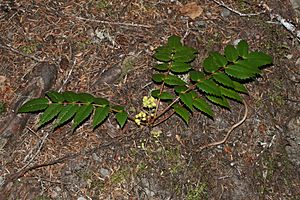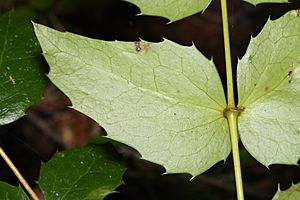Dwarf Oregon-grape facts for kids
Quick facts for kids Dull Oregon-grape |
|
|---|---|
 |
|
| Scientific classification | |
| Genus: |
Mahonia
|
| Species: |
nervosa
|
| Synonyms | |
|
|
The Dull Oregon-grape (also known as Mahonia nervosa) is a beautiful flowering plant. People also call it dwarf Oregon-grape or Cascade Oregon-grape.
This plant grows naturally along the northwest coast of North America. You can find it from southern British Columbia down to central California. There's also a small group of them far inland in northern Idaho.
Dull Oregon-grape loves to grow in forests. It's often found where Douglas-fir or western redcedar trees grow. It uses the small patches of sunlight that reach the forest floor.
Some scientists think that all plants in the Mahonia group should actually be part of the Berberis group.
This plant was first collected by Lewis and Clark. They found it during their famous Lewis and Clark Expedition to the western United States. Scientists officially described the plant in 1813.
Contents
What Does Dull Oregon-Grape Look Like?
The Dull Oregon-grape is an evergreen shrub. This means it stays green all year round. It has short stems that usually grow less than 30 centimeters (about 1 foot) tall.
However, its leaves can reach much higher. They sometimes grow up to 2 meters (about 6.5 feet) tall. The leaves are compound, meaning each leaf is made up of many smaller parts. It has 9 to 19 small leaflets.
Each leaflet has strong, sharp teeth along its edges. This makes them look a bit like holly leaves. They are also a little bit shiny.
Unlike some other Oregon-grapes, these leaflets do not have one main vein in the middle. Instead, they have several veins that spread out like a fan from the base of the leaflet. This is why it's called nervosa, which means "many-veined."
The flowers and fruit of the Dull Oregon-grape are similar to other Oregon-grape plants. Their fruits taste quite sour.
How People Use Dull Oregon-Grape
Long ago, some Plateau Indian tribes used this plant. They would make a special drink from the root. They drank it to help with rheumatism, which causes pain in joints and muscles.
The Yana people would dry the fruits of the Dull Oregon-grape. Then they would grind them up to make a type of mush. The fruits can also be dried and eaten like raisins.
Images for kids
See also
 In Spanish: Berberis nervosa para niños
In Spanish: Berberis nervosa para niños



